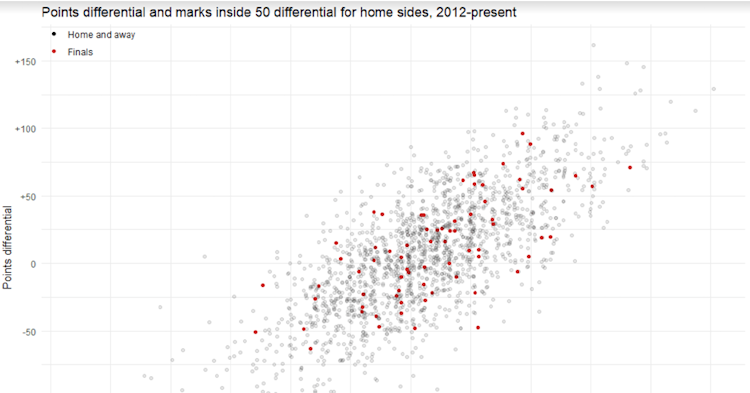AFL | Stats That Matter: How Footy Changes When Finals Start
Last updated: Sep 23, 2020, 8:28AM | Published: Sep 22, 2020, 11:47PM
The home and away portion of the 2020 AFL season has come to an end and there are now just nine games left that will decide which of our eight finals sides goes home with the premiership cup.
But finals differs from the regular season in more ways than simply the importance of the outcomes – there’s some key statistical trends that show how footy changes once the post-season arrives.
Let’s start with the thing that keeps Steve Hocking up at night: points scored. As you might have guessed, this is a stat that often changes significantly once we reach finals.
In 18 of the last 20 seasons the average total match score in finals has been lower than it was in the preceding home-and-away season. Last year, scores declined by nearly 11 points per game once we reached September.
So we know that finals generally see less points scored than a home-and-away match - but why is that so?
Simply put, teams lift their defensive efforts when it comes to the deciding matches of the season. 17 of the last 20 seasons have seen the number of tackles per game rise in finals compared to the home-and-away.
This has a number of flow-on effects, but the biggest is that teams struggle to find as much uncontested possession as they would in the home-and-away.
For the last 12 seasons in a row uncontested possession numbers have declined during finals compared to the regular season, often by significant amounts.
In 2019, there were 43 less contested possessions per game once finals arrived, and in 2017 and 2018 the gap was even wider.

What’s interesting is that these numbers aren’t necessarily replaced with contested possessions. While finals do generally see a few more CPs per game, it’s not enough to make up the gap.
Instead, finals matches typically see significantly less disposals recorded than in the home and away, presumably because the ball spends a larger chunk of time in dispute.
However while there are less disposals, there aren’t less inside-50s or less metres gained – these stats both tend to stay relatively stable between regular season and finals matches.
RELATED: Understanding how Clearances Shape the Results of AFL Games
Instead, players are more likely to kick when they dispose of the ball in finals than they are in the regular season - in the 2019 finals, 62.5% of disposals were kicks compared to 59% in the home-and-away.
This has the effect of teams gaining more metres per disposal, but also means teams are more likely to turn the ball over, or less likely to achieve a quality inside-50 entry.
From 2012-present every season has seen the percentage of disposals that are turnovers increase during finals, albeit not always by a significant amount.
In 2018 it went from 19% in the home and away to 21.5% in finals, last year it was from 19.1% to 20.3%.
This no doubt contributes to three other key trends: defenders win a higher percentage of contests, less marks inside-50 are recorded, and accuracy when kicking for goal decreases.
That explains why we don’t see as many points scored in finals as we would in the regular season. But does it point teams in the direction of a silver bullet stat that a finals game-plan should be built around? Unfortunately, no.

If such a stat is out there, I haven’t found it. The reality is that most of the numbers that indicate you’re doing well in the regular season indicate the same in finals, and vice versa.
Take the above scatter plot for example, which shows the marks-inside-50 differential and points scored differential for every home team from 2012 till the present.
Given what we already noted about the difficulty of achieving good forward entries in finals, it might be reasonable to guess that this stat is even more important in finals than it is during the regular season – but the data doesn’t really back that idea up.
The home-and-away matches (shown in grey) show a linear trend that is no less strong than that of finals matches (shown in red).
And it’s a similar story for other key stats like contested or uncontested possessions, intercepts, kicking efficiency, goal kicking accuracy, or offensive contests won – they continue to be important, but not necessarily moreso than they are at any other time of year.
RELATED: AFL 2020 Finals- Why Your Club Might Not Win The Premiership
To put it simply, there’s more than one way to win a final. While Richmond and West Coast have won flags despite being below-average sides for uncontested possession in recent years, other recent premiers like Hawthorn and the Bulldogs have been dominant uncontested possession sides.
There is however a stat which is important during the home-and-away but not so much during finals – and it may come as a bit of surprise.
 This plot is similar to the previous but instead shows the experience differentials and points
scored differentials for home teams from 2012-present.
This plot is similar to the previous but instead shows the experience differentials and points
scored differentials for home teams from 2012-present.
In the home-and-away season there is a trend that more experienced teams do better on the scoreboard- but the same trend isn’t present in finals.
That suggests that once the finals start, it really is on for young and old. Experience may help you get there, but it doesn’t necessarily shape who wins from there on out.
This year’s finals series features some up-and-coming young teams like the Bulldogs, Saints and Lions, and the numbers here suggest their inexperience is no reason to write them off.
That could make for a very exciting finals series to come – here’s looking forward to it.
Did you enjoy this article? Join our free mailing list to get the best content delivered straight to your inbox, or join the conversation by leaving a comment below or on the Stats Insider Twitter or Facebook page.



